A Broadwell Retrospective Review in 2020: Is eDRAM Still Worth It?
by Dr. Ian Cutress on November 2, 2020 11:00 AM ESTGaming Tests: Red Dead Redemption 2
It’s great to have another Rockstar benchmark in the mix, and the launch of Red Dead Redemption 2 (RDR2) on the PC gives us a chance to do that. Building on the success of the original RDR, the second incarnation came to Steam in December 2019 having been released on consoles first. The PC version takes the open-world cowboy genre into the start of the modern age, with a wide array of impressive graphics and features that are eerily close to reality.
For RDR2, Rockstar kept the same benchmark philosophy as with Grand Theft Auto V, with the benchmark consisting of several cut scenes with different weather and lighting effects, with a final scene focusing on an on-rails environment, only this time with mugging a shop leading to a shootout on horseback before riding over a bridge into the great unknown. Luckily most of the command line options from GTA V are present here, and the game also supports resolution scaling. We have the following tests:
- 384p Minimum, 1440p Minimum, 8K Minimum, 1080p Max
For that 8K setting, I originally thought I had the settings file at 4K and 1.0x scaling, but it was actually set at 2.0x giving that 8K. For the sake of it, I decided to keep the 8K settings.
For our results, we run through each resolution and setting configuration for a minimum of 10 minutes, before averaging and parsing the frame time data.
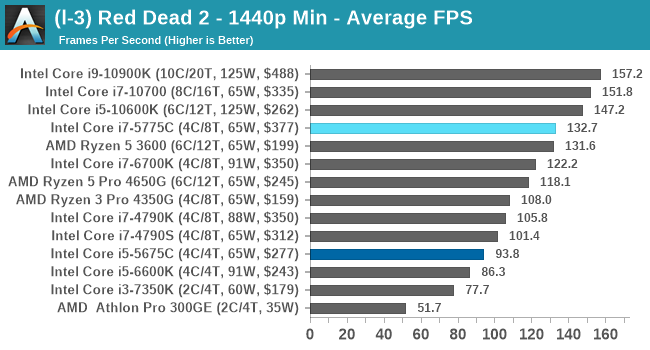
| AnandTech | Low Res Low Qual |
Medium Res Low Qual |
High Res Low Qual |
Medium Res Max Qual |
| Average FPS | 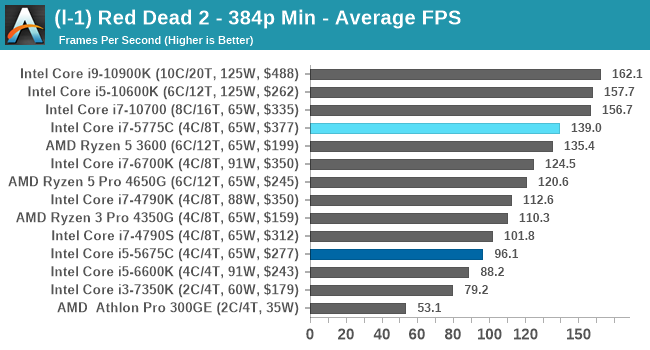 |
 |
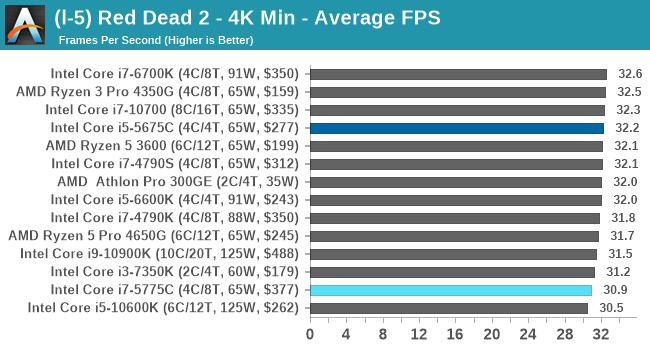 |
 |
| 95th Percentile | 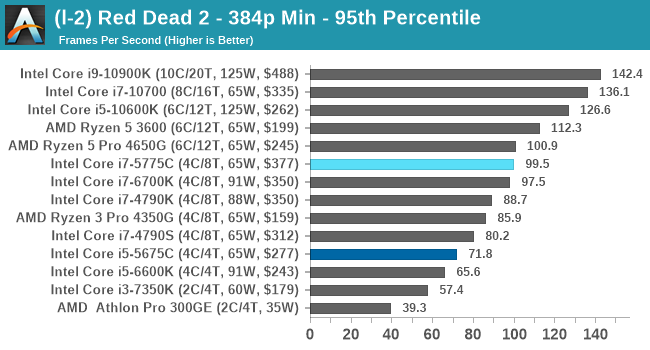 |
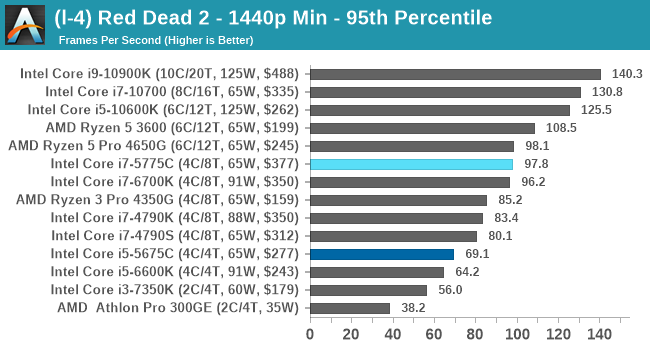 |
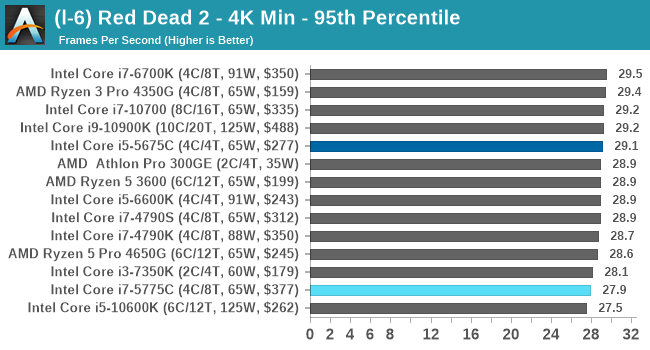 |
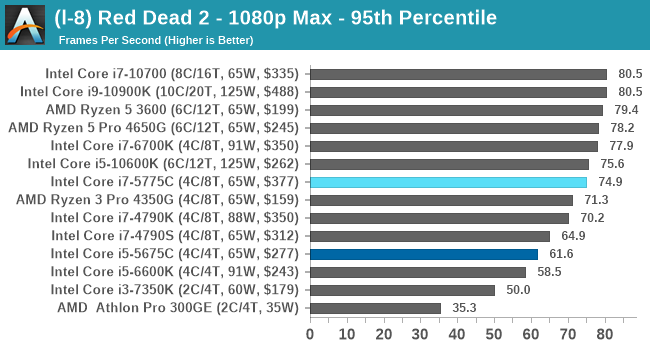 |
All of our benchmark results can also be found in our benchmark engine, Bench.











120 Comments
View All Comments
bernstein - Monday, November 2, 2020 - link
GDDR6 would be ideally suited as an L4 CPU cache... it has >500GB/s throughput and relatively low cost...e36Jeff - Monday, November 2, 2020 - link
Sure, if you build a 256-bit bus and somehow cram 8 GDDR6 chips onto the CPU package. You'd also be losing 30-40W of TDP to that.This is an application that HBM2 would be much better for. You can easily cram up to 4GB into the package with a much lower TDP impact and still get your 500+GB/s throughput. The biggest issue for this is going to be the impact of having to add in another memory controller and the associated die space and power that it eats up.
FreckledTrout - Monday, November 2, 2020 - link
This is also how I see it playing out. Certainly by the time Intel/AMD switch to using GAAFET maybe before. You just need a couple die shrinks that bring densities up and power down.bernstein - Monday, November 2, 2020 - link
scratch that, GDDR6 has much too high latency...stanleyipkiss - Monday, November 2, 2020 - link
The 5775C was ahead of its time. Don't know why they didn't go down that rabbit hole (of increasing the size with each gen)hecksagon - Monday, November 2, 2020 - link
Adding an extra 84mm2 of die area is a recipe for margin erosion, especially when the benefit is situational.CrispySilicon - Monday, November 2, 2020 - link
Well, I use a 5775C for my main home PC (using it now) and it's more than that. Broadwell was designed for low power. It doesn't run well over 4Ghz and it's not made to.My rig idles at about 800mhz, clocks up to 4ghz on all cores, 2ghz on the edram, and 2ghz on DDR3L (overclocked 1866 hyperx fury), yes, 3L, becuase THAT'S where the magic happens. Low power performance.
I've also used TridentX 2400CL10 modules in it, not worth the higher voltage.
I'm going to upgrade finally next year. CXL and DDR5 will finally retire this diamond in the rough.
Retest with nothing in the BIOS changed except the eDRAM multiplier to 20 and see what happens.
Notmyusualid - Wednesday, November 4, 2020 - link
I usually run my Broadwell at 4.4GHz 24/7. However I have a failed bios battery so using the m/b default 4.0GHz overclock settings today. I don't let mine idle at low speeds, its High Performance mode only & I only boot the Desktop for gaming, or Software Define Radio. Both of which want GHz.Memory is Vengeance LED 3200MHz (CL15 & only stable at 3000MHz, XMP is not stable either), and 32GB is currently installed.
Given;
C:\Windows\System32>winsat mem
Windows System Assessment Tool
> Running: Feature Enumeration ''
> Run Time 00:00:00.00
> Running: System memory performance assessment ''
> Run Time 00:00:05.45
> Memory Performance 54386.55 MB/s
> Total Run Time 00:00:06.65
I think that is why my Broadwell missed out on any eDRAM - it wasn't necessary.
Dolphin runs about 35x seconds, as I remember it.
6950X running cool in 2020...
MrCommunistGen - Monday, November 2, 2020 - link
HA. Epic timing. Just starting to read this now, but I recently built a system with a Broadwell-based Xeon E3 chip I got for cheap on eBay. Mostly just because I wanted to play with a chip that had eDRAM and the price of entry for an i5 or i7 has remained pretty high.This will be a very interesting read!
alufan - Monday, November 2, 2020 - link
News all day as long as its about Intel so it seems on here said it before and have seen nothing since to change my mind